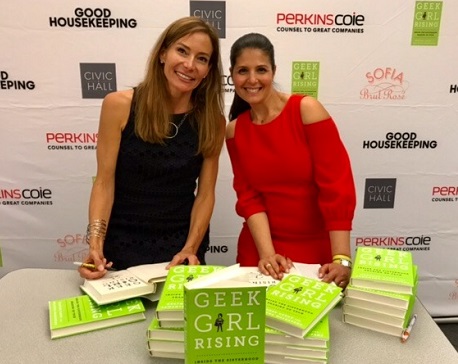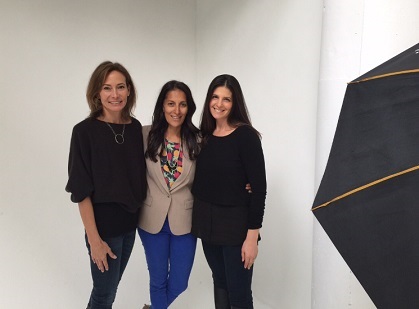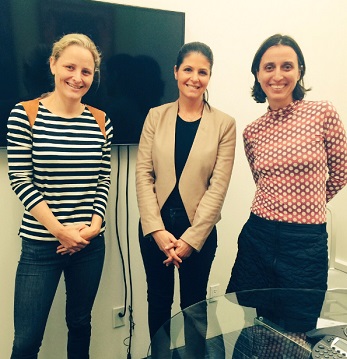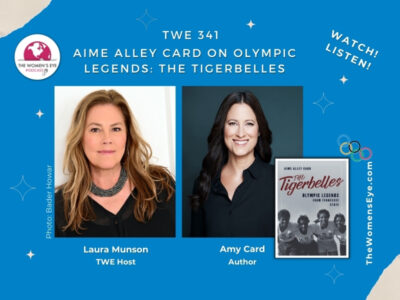
By Patricia Caso/July 28, 2017
Photos Courtesy Samantha Walravens and Heather Cabot
“Dream It, Do It, Own It” is one of the chapter titles for Geek Girl Rising–Inside the Sisterhood Shaking Up Tech, authored by Heather Cabot and Samantha Walravens. That title is bigger than a motivational thought. It aptly describes the women in STEM (science, technology, engineering, math) who have been consistently breaking through in the tech world for years now.
“Geek Girl Rising is on a mission to elevate the voices of women in technology and encourage women and girls to join the digital revolution – and create the future!” Samantha Walravens
In fact, now there are more support systems, role models and careers for young girls who have STEM interests. I wanted to find out more from Heather and Samantha about their findings on what STEM opportunities and challenges face young “geek” women and coming generations…
EYE: How did you both meet and then decide to write the Geek Girls Rising book?
HEATHER: Sam edited an anthology of essays about motherhood and work called Torn: True Stories of Kids, Career & the Conflict of Modern Motherhood and the book featured one of my pieces. It came out in 2011.
We stayed in touch and realized we were both interested in learning more about the gender gap in tech and decided to team up in 2015 to write the book proposal.
Despite the headlines of the decline of women in tech, we found many women who were doing some amazing work and having success in STEM. We felt that their stories were not being told, that they had been glossed over, yet they very much deserved recognition.
EYE: What would your definition of “geek” be for geek girls?
SAM: Our definition of “geek” is broad and includes anyone who is passionate about using technology to build the future. The word “geek” used to have negative connotations, bringing to mind social misfits and awkward boy geniuses. That image is fading fast as new generations are born and raised with technology in their hands.
In today’s world, technology is part of our everyday lives, whether we’re reading the news, shopping, communicating with family and friends, or figuring out the fastest way to work. In a way, we are all “geeks.”
EYE: How does today’s geek girl differ from the previous generations?

HEATHER: In previous generations, women who worked in tech didn’t have the glory roles and yet they were the ones doing much of the work behind the scenes. Women who had majored in math were the original “computers” or programmers during WW II. Computing did not begin to gain more mainstream cachet until the Eighties and the dawn of the personal computer.
SAM: The stereotype of the nerdy “geek” guy coding away in a dark basement is disappearing, like the 1980s Revenge of the Nerds type of movies that created it. In fact, women have always been part of “geek” culture, from Ada Lovelace in the 19th century to Grace Hopper in the 20th to Marissa Mayer in the 21st.
But like the movie Hidden Figures illustrates, women have been largely kept out of the narrative. The good news is that, in the past several years, women have started making their voices heard about their “geeky” passions and love of technology.
Geek Girl Rising is on a mission to elevate the voices of women in technology and encourage women and girls to join the digital revolution – and create the future.
EYE: In your subtitle, Inside the Sisterhood Shaking Up Tech, how important is that word sisterhood?
HEATHER: Every woman we feature in the book personifies sisterhood in the way that they help other women. From being generous with contacts and sharing expertise to launching new programs to help women network and learn leadership skills to making personal financial investments in women-led companies, the book highlights the different ways women can support each other in the innovation economy.
It’s important for young girls to observe these kinds of interactions – whether it’s in the material they are reading in school or having the opportunity to see it in action.
Sam and I sometimes brought our daughters along with us while we were reporting for the book and they had the chance to see the sisterhood in action.
EYE: It seems to me that women tend to be instinctively innovative. How do young women get up to speed and participate in the STEM fields?
HEATHER: Young girls need to envision themselves as creators, builders and inventors. This is the reason we kick off the book with the story of GoldieBlox and the company’s founder’s mission to dispel the stereotype of an engineer with her line of toys.
It’s important to note that in terms of STEM, the critical shortage of women is in computing and engineering.
SAM: In our research, we discovered a new type of feminism where women are helping each other succeed in the startup world. There are female-focused co-working spaces like Hera Hub and The Wing, to accelerator programs like the Women’s Startup Lab and MergeLane that support and invest in female founders.
Now at many college campuses women in engineering and computer science are forming networks to address gender disparities and inspire the next generation of girls in tech.
As Shelley Zalis, CEO and Founder of the Girls’ Lounge, says, “A woman alone can be powerful. But collectively, we have an impact.”

Founder/CEO of The Boardlist
EYE: What needs to be done so there is an awareness for STEM career options?
HEATHER: We need to see women in STEM careers represented in the media – on TV and in film – on Netflix! This is why we are so thrilled that the book is being developed into a scripted TV series by the production company owned by Kelly Ripa and Mark Consuelos and ABC Studio.
SAM: We need to showcase examples of women who are succeeding in the tech world – as entrepreneurs, engineers and investors – so that our daughters have role models. As they say, “You can’t BE what you can’t SEE.”
EYE: Do you consider yourselves geeks?
HEATHER: I love technology, although I will admit learning to code is still on my bucket list. Maybe this year. To me, being a geek means being smart and super curious about how things work. I consider myself a geek.
SAM: My first job out of grad school was creating the first online edition of PC World magazine. We used HTML 1.0, and this was before we had tools that made it easy to develop websites. So I guess I can consider myself a “coder.”
Ironically, at that time in 1995, I was more interested in moving upstairs to the editorial offices of the magazine and becoming a reporter. Coding was considered somewhat of a menial task. It was far from sexy!
EYE: You happen to have daughters who are already interested in the STEM arena. What do they enjoy about it?
HEATHER: My daughter is actually at an overnight coding camp this week studying cybersecurity and hacking! My other daughter, who is 11, loves to read and tell stories. Minecraft was her first real exposure to programming and she loved designing landscapes and stories around the characters in her Minecraft worlds (so did her twin brother).
SAM: I have two girls–Coco is 13, Gigi is 9–who, like most kids today, spend a lot of time messaging their friends, posting on social media and playing Minecraft. As a mom, I want to make sure my daughters learn how to create technology, not just consume it.
My 9 year old did an after-school robotics class this year, which was run through our local library. She loved it, especially because she’s super social and did it with her girlfriends.
My 13 year old is going into 8th grade and has a YouTube channel called The Daily Dish where she and a friend whip up fun, kid-friendly recipes and also do wacky science experiments.

co-founders of Power to Fly
EYE: For many people, myself included, coding is simply not easy. Do you have any advice on getting through the difficult times when a daughter or son or student just can’t “crack” the process?
HEATHER: I think it depends on the age but in general, it is fine to take a break and step away. I also think there are more and more game-like apps and toys that teach basic skills. It should be fun!
SAM: Find friends to work with. Don’t be afraid to raise your hand in class to ask questions, or get help from your teacher after class. Get a tutor if you need it. Don’t give up when it gets hard. You don’t need straight A’s in school to succeed in tech!
EYE: With all the women you featured, is there a pattern in their successes?
HEATHER: They were out to solve a problem. They were comfortable with uncertainty and not having all the answers. They were resilient and did not falter when things didn’t go as planned.

EYE: Is there a woman out there now, in the book or not, whom you feel epitomizes a geek girl rising?
SAM: I love the story we tell of Dona Sarkar, who is a lead engineer at Microsoft. She failed her first computer science class in college because she was embarrassed to raise her hand and ask questions.
She was afraid the other students in the class – mostly boys – would think she was an airhead. So she ended up with an F. She says learning to code is like riding a bike–the first couple of times you do it, you fall off, skin your knee, cry.
But you get back in the saddle and try again. Eventually, you are riding and never look back! Similarly, she didn’t let her first failure in CS prevent her from getting “back in the saddle.”
She took the class again, got a B, and ended up majoring in Computer Science! Hers is a story of resilience and grit. Dona is a true “geek girl.”
 HEATHER: Too many to name!
HEATHER: Too many to name!
EYE: Was there anything that you were surprised to find out in pulling together all the interviews?
HEATHER: The biggest surprise is that we had way too much material. There really are so many women doing newsworthy things around technology.
SAM: Before I partnered with Heather, I was researching the topic of sexism in Silicon Valley. Unfortunately, it’s a big problem and the majority of women I spoke with had been subjected to sexual harassment, gender bias or discrimination in some form.
What surprised me how these women were forging ahead and succeeding, despite the male-dominated and often sexist world they inhabited. They weren’t going to let sexism stop them from pursuing their passion. It was so inspiring!
EYE: As you look to the future, what do you see these young women geeks rising to challenge and succeeding in?
HEATHER:I see them building and leading the companies of tomorrow and funding the next generation of startups.
EYE: And, next for you both?
HEATHER: We are working with Home Shopping Network and I have several speaking engagements as well as beginning to dig into the research for the next book.
SAM: I’ll continue writing for Forbes, the Huffington Post and Disney Online– sharing the stories and success strategies of amazing women in tech and offering advice for the next generation of “geek girls”! When Geek Girl Rising goes prime time, Heather and I will consult for the show.
EYE: If you could give one piece of advice to young girls everywhere, what would it be?
HEATHER: Don’t give up. Remember that stumbles are all part of the journey and often you learn much more in defeat than when you succeed.
SAM: Don’t do it alone. Find your “tribe” — mentors, advisors, coaches and others who will support you on your journey.
EYE: Here’s to the many readers who will be inspired by your work and make the world a better place! Thank you, Heather and Samantha for your insights and continued success in all you do!
###
TWITTER: Samantha Walravens
TWITTER: Heather Cabot
TWITTER: Geek Girl Rising



Leave a Reply